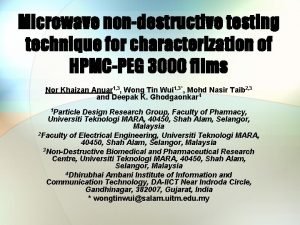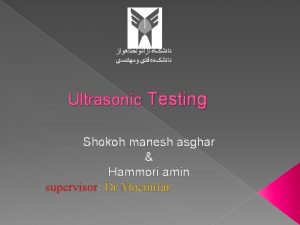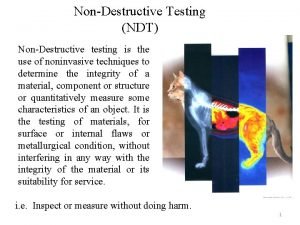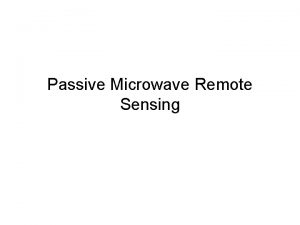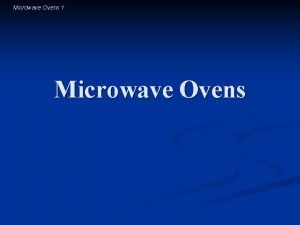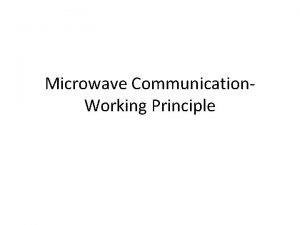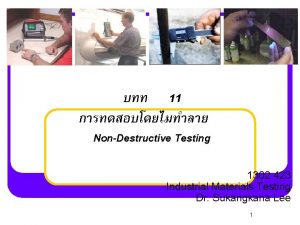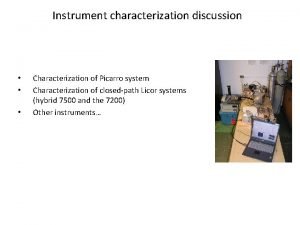Microwave nondestructive testing technique for characterization of HPMCPEG
















![REFERENCES [1] S. T. Narisetty and P. Ramesh, “Transdermal Delivery of Zidovudine: Effect of REFERENCES [1] S. T. Narisetty and P. Ramesh, “Transdermal Delivery of Zidovudine: Effect of](https://slidetodoc.com/presentation_image_h/d53c5cfeb902f08cf6e8227e84b4455d/image-17.jpg)

- Slides: 18

Microwave non-destructive testing technique for characterization of HPMC-PEG 3000 films Nor Khaizan Anuar 1, 3, Wong Tin Wui 1, 3*, Mohd Nasir Taib 2, 3 and Deepak K. Ghodgaonkar 4 1 Particle Design Research Group, Faculty of Pharmacy, Universiti Teknologi MARA, 40450, Shah Alam, Selangor, Malaysia 2 Faculty of Electrical Engineering, Universiti Teknologi MARA, 40450, Shah Alam, Selangor, Malaysia 3 Non-Destructive Biomedical and Pharmaceutical Research Centre, Universiti Teknologi MARA, 40450, Shah Alam, Selangor, Malaysia 4 Dhirubhai Ambani Institute of Information and Communication Technology, DA-IICT Near Indroda Circle, Gandhinagar, 382007, Gujarat, India * wongtinwui@salam. uitm. edu. my

CONTENT 1. 0 INTRODUCTION 2. 0 EXPERIMENTAL 2. 1 Materials 2. 2 Sample preparation 2. 3 Physicochemical characterization 3. 0 RESULTS AND DISCUSSION 4. 0 CONCLUSION ACKNOWLEDGEMENT REFERENCES

1. 0 INTRODUCTION • Transdermal drug delivery system (TDDS) utilizes the skin for the delivery of drug molecules from the surface of the skin, through its layers, to the circulatory system. • Quality control of matrix characteristics, such as state of polymer-polymer and drug-polymer interaction, is essential with respect to therapeutic effectiveness of a TDDS.

• In the pharmaceutical industry, the analytical techniques such as differential scanning calorimetry (DSC) and Fourier transform infra-red spectroscopy (FTIR) have long been employed to determine the matrix characteristics of a TDDS. • However, these techniques result in sample being unrecoverable from test and restrict the analysis to statistically selected samples.

• The present study sets to explore the applicability of microwave NDT technique as an optional tool to characterize the matrix property of polymer film for use as a transdermal drug delivery system.

2. 0 EXPERIMENTAL 2. 1 Materials • Hydroxypropylmethylcellulose (HPMC, Dow Chemical Company, USA) – matrix polymer. • Loratadine (Morepen Laboratories, India) – model drug. • Polyethylene glycol (PEG 3000, Merck, Germany) – plasticizer.

2. 2 Sample preparation • The films were prepared using solvent evaporation method. • The films were conditioned in a desiccator at 25 1 °C and at three different levels of relative humidity (25 5 %, 50 5 % and 75 5 %) for at least 5 days prior to the physicochemical characterization.

Sample HPMC (mg) PEG 3000 (mg) Loratadine (mg) H 0 37. 5 0 0 P 0 37. 5 3. 75 0 P 1 37. 5 3. 75 5 P 2 37. 5 3. 75 20 Table 1: Theoretical contents of HPMC, PEG 3000 and loratadine in films.

2. 3 Physicochemical characterization • The formed film was subjected to drug content assay using UV spectrophotometry technique, DSC, FTIR and microwave NDT analysis. Fig. 1: Rectangular dielectric waveguide (RDWG) measurement system.

3. 0 RESULTS AND DISCUSSION i) Drug content analysis: Sample Film thickness (mm) Relative humidity (%) 25 50 75 Loratadine content (%w/w) H 0 0. 031 0. 006 0 0 0 P 0 0. 036 0. 003 0 0 0 P 1 0. 064 0. 015 12. 15 0. 32 13. 59 0. 36 13. 06 0. 16 P 2 0. 114 0. 033 39. 06 0. 93 35. 06 1. 14 38. 04 1. 34 Table 2: Drug content of films measured using the UV spectrophotometry technique. The drug content of films was not affected by the level of relative humidity in the storage chamber (ANOVA: p > 0. 05). A flat film was formed. A thicker film was formed in sample containing a higher content of drug load.

ii) DSC analysis: PEG 3000 HPMC film = Tm = Polymer-plasticizer interaction was effected. H 0, P 1 & P 2 Tm 25, 50, 75% RH H Similar exotherm was not found in thermograms of films stored at the higher levels of relative humidity, as it was probably masked by the melting endotherms of the same thermogram. Tm H An exotherm was found in thermogram of film P 0 stored at the relative humidity of 25%.

iii) FTIR analysis: PEG 3000 HPMC film = induced polymerplasticizer interaction via O-H moiety H 0 P 0 RH (%) 25 50 75 O-H & C-H Functional group Sample P 1 P 2 a. C=C C-H O-H

iv) Microwave NDT analysis: Frequency 8 GHz RH (%) 25 H 0 P 0 50 n. PAC ; n. PTC 12 GHz RH (%) 75 25 50 n. PAC ; n. PTC 75 O-H & C-H Sample P 1 n. PAC ; n. PTC O-H & a. C=C P 2 n. PAC ; n. PTC O-H & C-H

• From the previous study of our laboratory, it was found that the measurement of microwave NDT test at 8 GHz was sensitive to the chemical environment involving polar moiety such as O-H functional group, while it was greatly governed by the less polar C-H moiety in test conducted at 12 GHz. • The present findings indicated that the changes of both polar and apolar environments of HPMC-PEG 3000 films were reflected accordingly by the microwave NDT measurements conducted at the frequency bands of 8 and 12 GHz respectively.

4. 0 CONCLUSION • The measurements of microwave NDT test at 8 and 12 GHz were sensitive to the changes of chemical environment in matrix involving polar functional group such as O-H moiety and less polar functional group such as C-H and aromatic C=C moieties. • The present investigation verified that the microwave NDT technique has the capacity to evaluate the state of interaction between polymer, plasticizer and/or drug of a binary polymeric matrix, in addition to the existing DSC and FTIR techniques.

ACKNOWLEDGEMENT • The authors wish to express their heart-felt gratitude to Institute of Research, Development and Commercialization, Ui. TM for financial support and motivation given throughout the research project.
![REFERENCES 1 S T Narisetty and P Ramesh Transdermal Delivery of Zidovudine Effect of REFERENCES [1] S. T. Narisetty and P. Ramesh, “Transdermal Delivery of Zidovudine: Effect of](https://slidetodoc.com/presentation_image_h/d53c5cfeb902f08cf6e8227e84b4455d/image-17.jpg)
REFERENCES [1] S. T. Narisetty and P. Ramesh, “Transdermal Delivery of Zidovudine: Effect of Vehicles on Permeation Across Rat Skin and their Mechanism of Action, ” Euro. J. Pharm. Sc. , vol. 18, pp. 71 -79, 2003. [2] N. K. Pramila and R. V. Pradeep, “Eudragits: Role as Crystallization Inhibitors in Drug-In-Adhesive Transdermal Systems of Estradiol, ” Euro. J. Pharm. and Biopharm. , vol. 52, pp. 173– 180, 2001. [3] K. J. Amit, S. T. Narisetty and P. Ramesh, “Transdermal Drug Delivery of Imipramine Hydrochloride. I. Effect of Terpenes, ” J. Cont. Rel. , vol. 79, pp. 93– 101, 2002. [4] X. Yu, X. Bai and G. Yunhua, “Controlled Transdermal Delivery of Model Drug Compounds by MEMS Microneedle Array, ” Nanomedicine: Nanotechnology, Biology, and Medicine, vol. 1, pp. 184 -190, 2005. [5] C. W. Robert, J. A. Melvin and H. B. William, CRC Handbook of Chemistry and Physics, 69 th Ed. , CRC Press, Inc. , Florida, 1989. [6] A. Zulkifly, D. P. Roger and W. K. Robert, “Determination of the Dielectric Constant of Materials from Effective Refractive Index Measurements, ” IEEE Trans. on Inst. & Meas. , vol. 47, pp. 148 -152, 1998. [7] A. Nor Khaizan, T. W. Wong, D. K. Ghodgaonkar and T. Mohd Nasir, “Characterization of Hydroxypropylmethylcellulose Films using Microwave Non-Destructive Testing Technique, ” Journal of Pharmaceutical and Biomedical Analysis, vol. 43, pp. 549– 557, 2007.

 Introduction to nondestructive testing
Introduction to nondestructive testing Weld testing methods
Weld testing methods Microwave testing ndt
Microwave testing ndt Characterization
Characterization What is direct and indirect characterization
What is direct and indirect characterization Tandem technique in ultrasonic testing
Tandem technique in ultrasonic testing Test design techniques
Test design techniques Motivational overview of logic based testing
Motivational overview of logic based testing Decision table based testing
Decision table based testing Anuj magazine
Anuj magazine Domain testing in software testing
Domain testing in software testing Decision table testing in software testing
Decision table testing in software testing Data flow testing strategies in software testing
Data flow testing strategies in software testing Rigorous testing in software testing
Rigorous testing in software testing Functional testing vs unit testing
Functional testing vs unit testing Jenis-jenis black box testing
Jenis-jenis black box testing Positive testing vs negative testing
Positive testing vs negative testing Testing blindness in software testing
Testing blindness in software testing Control structure testing in software engineering
Control structure testing in software engineering


